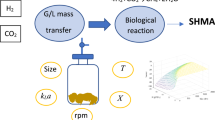Summary
A method for the quantitative measurement of the maximum growth rate (μm) of hydrogen-consuming methanogenic populations was applied to assess the toxicity of ammonia1 under various pH and temperature conditions. The maximum uninhibited growth rate of the hydrogenotrophic population present in sludge from an industrial anaerobic wastewater treatment system appeared to be 0.126 h-1 at pH=7 and 37°C. At 350 mM ammonia the maximum growth rate had decreased to almost half that value. At a temperature of 29°C the maximum growth rates in the ammonia range tested appeared to be approximately 60% of that at 37°C, while increasing ammonia concentrations caused a similar maximum growth rate decline. At 37°C an increase of the pH to 7.8 appeared to enhance ammonia inhibition of the maximum growth rate. Increased propionate concentrations (tested up to 60 mM) appeared to have no effect on ammonia inhibition.
Similar content being viewed by others
References
Albertson OE (1961) Ammonia nitrogen and the anaerobic environment. J Water Pollut Control Fed 33:978–995
Anderson GK, Donnelly T, McKeown KJ (1982) Identification and control of inhibition in anaerobic treatment of industrial wastewaters. Proc Biochem 17(4):28–32/41
Andrews JF (1969) Dynamic model of the anaerobic digestion process. J Sanit Eng Div 95:95–116
Dubach AC, Bachofen R (1985) Methanogens: a short taxonomic review. Experientia 41:441–446
Gujer W, Zehnder AJB (1983) Conversion processes in anaerobic digestion. Water Sci Technol 15:127–167
Hobson PN, Shaw BG (1976) Inhibition of methane production by Methanobacterium formicicum. Water Res 10:849–852
Jeris JS, McCarty PL (1965) The biochemistry of methane fermentation using 14C tracers. J Water Pollut Control Fed 37:178–192
Koster IW (1986) Characteristics of the pH-influenced adaptation of methanogenic sludge to ammonium toxicity. J Chem Tech Biotechnol 36:445–455
Koster IW, Lettinga G (1984) The influence of ammoniumnitrogen on the specific acitivity of pelletized methanogenic sludge. Agric Wastes 9:205–216
Koster IW, Lettinga G (1985) Application of the upflow anaerobic sludge bed (UASB) process for treatment of complex wastewaters at low temperatures. Biotechnol Bioeng 27:1411–1417
Kugelman IJ, Chin KK (1971) Toxicity, synergism and antagonism in anaerobic waste treatment processes. In: Gould RF (ed) Anaerobic biological treatment processes (Advances in Chemistry Series 105). American Chemical Society, Washington, DC, pp 55–90
Lettinga G, Hulshoff Pol LW, Koster IW, Wiegant WM, De Zeeuw WJ, Rinzema A, Grin PC, Roersma RE, Hobma SW (1984) High-rate anaerobic wastewater treatment using the UASB reactor under a wide range of temperature conditions. In: Russell GE (ed) Biotechnology and genetic engineering reviews, vol 2. Intercept, Newcastle-upon-Tyne, UK, pp 253–284
Melbinger NR, Donnellon J (1971) Toxic effects of ammonianitrogen in high-rate digestion. J Water Pollut Control Fed 43:1658–1670
Meynell P-J (1982) Methane: planning a digester, 2nd edn, Prism Press, Chalmington, UK
Robinson JA, Tiedje JM (1984) Competition between sulfatereducing and methanogenic bacteria for H2 under resting and growing conditions. Arch Microbiol 137:26–32
Rose CS, Pirt SJ (1981) Conversion of glucose to fatty acids and methane: roles of two mycoplasmal agents. J Bacteriol 147:248–254
Schauer NL, Ferry FG (1980) Metabolism of formate in Methanobacterium formicicum. J Bacteriol 142:800–807
Shea TG, Pretorius WA, Cole RD, Pearson EA (1968) Kinetics of hydrogen assimilation in the methane fermentation. Water Res 2:833–848
Sprott GD, Patel GB (1986) Ammonia toxicity in pure cultures of methanogenic bacteria. System Appl Microbiol 7:358–363
Stumm W, Morgan JJ (1970) Aquatic chemistry, and introduction emphasizing chemical equilibria in natural waters. Wiley, New York
Velsen AFM van (1979) Anaerobic digestion of piggery waste. 2. Start-up procedure. Neth J Agric Sci 27:142–152 (1978)
Wise DL, Cooney CL, Augenstein DC (1978) Biomethanation: anaerobic fermentation of CO2, H2 and CO to methane. Biotechnol Bioeng 20:1153–1172
Wolin MJ, Miller TL (1982) Interspecies hydrogen transfer: 15 years later. ASM News 48:561–565
Zehnder AJB (1978) Ecology of methane formation. In: Mitchel R (ed) Water pollution microbiology, vol 2. Wiley, New York, pp 349–376
Zehnder ALB, Wuhrmann K (1977) Physiology of a Methanobacterium strain AZ. Arch Microbiol 111:199–205
Zehnder AJB, Huser BA, Brock TD, Wuhrmann K (1980) Characterization of an acetate-decarboxylating, non-hydrogen-oxidizing methane bacterium. Arch Microbiol 124:1–11
Author information
Authors and Affiliations
Rights and permissions
About this article
Cite this article
Koster, I.W., Koomen, E. Ammonia inhibition of the maximum growth rate (μm) of hydrogenotrophic methanogens at various pH-levels and temperatures. Appl Microbiol Biotechnol 28, 500–505 (1988). https://doi.org/10.1007/BF00268222
Received:
Accepted:
Issue Date:
DOI: https://doi.org/10.1007/BF00268222




